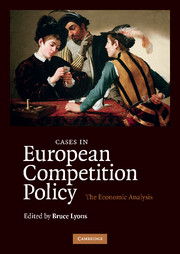Book contents
- Frontmatter
- Contents
- Contents by potentially anticompetitive business practices
- Contents by markets
- List of figures
- List of tables
- List of contributors
- Preface
- Introduction: the transformation of competition policy in Europe
- A Anticompetitive behaviour by firms with market power
- B Agreements between firms
- C Mergers
- Introduction
- C.1 Measurement of unilateral effects
- C.2 Coordinated effects
- C.3 Vertical and conglomerate effects
- 16 Vertical effects between natural gas and electricity production: the Neste–IVO merger in Finland
- 17 Horizontal, vertical and conglomerate effects: the GE–Honeywell merger in the EU
- Bibliography
- Index
16 - Vertical effects between natural gas and electricity production: the Neste–IVO merger in Finland
Published online by Cambridge University Press: 05 June 2012
- Frontmatter
- Contents
- Contents by potentially anticompetitive business practices
- Contents by markets
- List of figures
- List of tables
- List of contributors
- Preface
- Introduction: the transformation of competition policy in Europe
- A Anticompetitive behaviour by firms with market power
- B Agreements between firms
- C Mergers
- Introduction
- C.1 Measurement of unilateral effects
- C.2 Coordinated effects
- C.3 Vertical and conglomerate effects
- 16 Vertical effects between natural gas and electricity production: the Neste–IVO merger in Finland
- 17 Horizontal, vertical and conglomerate effects: the GE–Honeywell merger in the EU
- Bibliography
- Index
Summary
Background and introduction
In early 1998 the Finnish firms Neste Oy and Imatran Voima Oy (IVO) merged. It brought together a national monopoly in gas distribution with the largest supplier of electricity in Finland. The merger was evaluated by the European Commission, which reached its decision in June 1998. This chapter offers an evaluation of this merger in light of an analysis of the markets for natural gas and electricity production in Finland. The analysis is conducted with the perspective taken prior to the merger, in particular prior to the introduction of Nord Pool, i.e. the common power exchange between Sweden, Norway and Finland. For that reason we describe market conditions in terms of data available prior to the merger. Typically this refers to data on a yearly basis from 1996.
Neste focused on oil, energy (natural gas, liquefied petroleum and heat supply) and the chemical business. The Finnish state was the dominant shareholder, owning 83 per cent of the shares in Neste, which had a turnover of ECU 9,018 million. IVO was the largest Finnish energy company with business activities consisting of power and heat generation, power trading and electricity distribution and supply, operation and maintenance of power plants, energy measurement and grid services. The Finnish state owned almost 96 per cent of the shares in IVO, which had a worldwide turnover of ECU 2,342 million.
- Type
- Chapter
- Information
- Cases in European Competition PolicyThe Economic Analysis, pp. 413 - 433Publisher: Cambridge University PressPrint publication year: 2009



